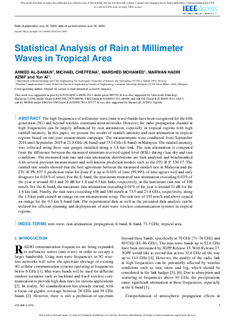| dc.contributor.author | Al-Samman, Ahmed | |
| dc.contributor.author | Cheffena, Michael | |
| dc.contributor.author | Mohamed, Marshed Kassim | |
| dc.contributor.author | Azmi, Marwan Hadri | |
| dc.contributor.author | Ai, Yun | |
| dc.date.accessioned | 2020-03-12T10:28:22Z | |
| dc.date.available | 2020-03-12T10:28:22Z | |
| dc.date.created | 2020-03-11T10:44:49Z | |
| dc.date.issued | 2020 | |
| dc.identifier.issn | 2169-3536 | |
| dc.identifier.uri | http://hdl.handle.net/11250/2646520 | |
| dc.description.abstract | The high frequencies of millimeter wave (mm-wave) bands have been recognized for the fifth generation (5G) and beyond wireless communication networks. However, the radio propagation channel at high frequencies can be largely influenced by rain attenuation, especially in tropical regions with high rainfall intensity. In this paper, we present the results of rainfall intensity and rain attenuation in tropical regions based on one-year measurement campaign. The measurements were conducted from September 2018 until September 2019 at 21.8 GHz (K-band) and 73.5 GHz (E-band) in Malaysia. The rainfall intensity was collected using three rain gauges installed along a 1.8 km link. The rain attenuation is computed from the difference between the measured minimum received signal level (RSL) during clear sky and rain conditions. The measured rain rate and rain attenuation distributions are then analysed and benchmarked with several previous measurements and well-known prediction models such as the ITU-R P. 530-17. The rainfall rate results showed that the best agreement between the measured rainfall rate in Malaysia and the ITU-R PN.837-1 prediction value for Zone P is up to 0.01% of time (99.99% of time agrees well and only disagrees for 0.01% of time). For the E-band, the maximum measured rain attenuation exceeding 0.03% of the year is around 40.1 and 20 dB for 1.8 and 0.3 km links, respectively, at the maximum rain rate of 108 mm/h. For the K-band, the maximum rain attenuation exceeding 0.01% of the year is around 31 dB for the 1.8 km link. Finally, the rain rates exceeding 108 and 180 mm/h at 73.5 and 21.8 GHz, respectively, along the 1.8 km path caused an outage on our measurement setup. The rain rate of 193 mm/h and above caused an outage for the 0.3 km E-band link. The experimental data as well as the presented data analysis can be utilized for efficient planning and deployments of mm-wave wireless communication systems in tropical regions. | nb_NO |
| dc.language.iso | eng | nb_NO |
| dc.publisher | IEEE | nb_NO |
| dc.relation.uri | https://ieeexplore.ieee.org/document/9028213 | |
| dc.rights | Navngivelse 4.0 Internasjonal | * |
| dc.rights.uri | http://creativecommons.org/licenses/by/4.0/deed.no | * |
| dc.title | Statistical Analysis of Rain at Millimeter Waves in Tropical Area | nb_NO |
| dc.type | Journal article | nb_NO |
| dc.type | Peer reviewed | nb_NO |
| dc.description.version | acceptedVersion | nb_NO |
| dc.source.journal | IEEE Access | nb_NO |
| dc.identifier.doi | 10.1109/ACCESS.2020.2979683 | |
| dc.identifier.cristin | 1801105 | |
| dc.description.localcode | This work is licensed under a Creative Commons Attribution 4.0 License. For more information, see https://creativecommons.org/licenses/by/4.0/. | nb_NO |
| cristin.unitcode | 194,64,94,0 | |
| cristin.unitname | Institutt for vareproduksjon og byggteknikk | |
| cristin.ispublished | true | |
| cristin.fulltext | postprint | |
| cristin.qualitycode | 1 | |

